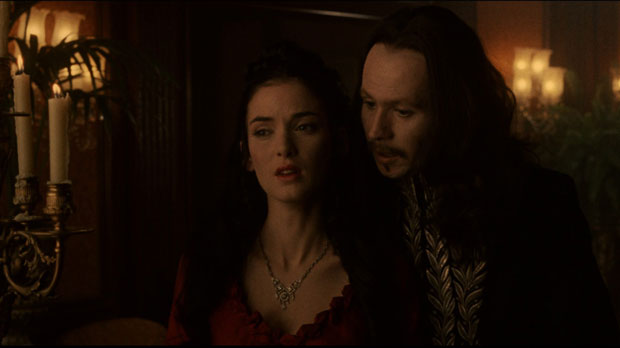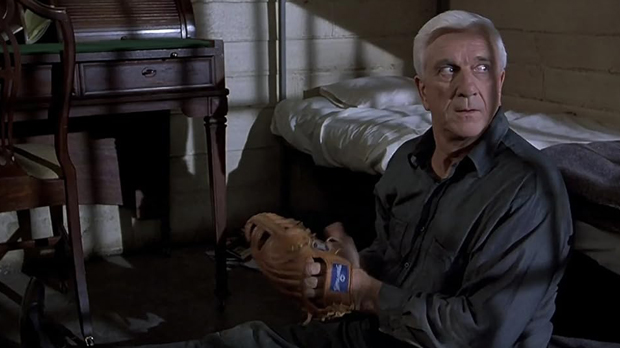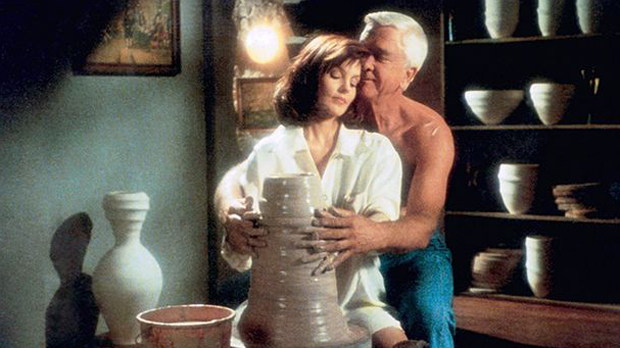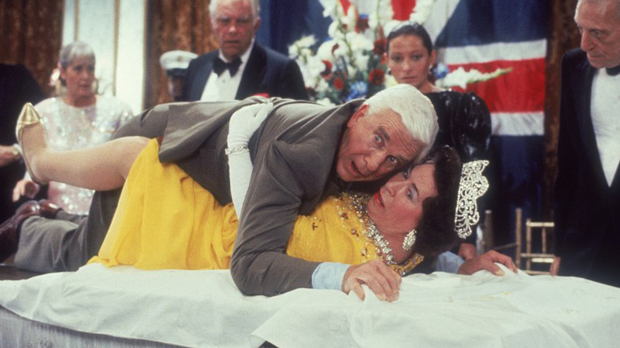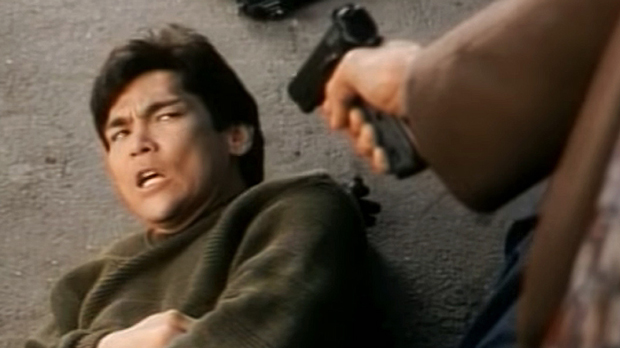 Bram Stoker’s Dracula (1992) Columbia/Horror RT: 128 minutes Rated R (sexuality/nudity, bloody horror violence, vampirism, drug use) Director: Francis Ford Coppola Screenplay: James V. Hart Music: Wojciech Kilar Cinematography: Michael Ballhaus Release date: November 13, 1992 (US) Cast: Gary Oldman, Winona Ryder, Anthony Hopkins, Keanu Reeves, Richard E. Grant, Cary Elwes, Bill Campbell, Sadie Frost, Yom Waits, Monica Bellucci, Michaela Bercu, Florina Kendrick, Jay Robinson. Box Office: $82.5M (US)/$215.8M (World)
Bram Stoker’s Dracula (1992) Columbia/Horror RT: 128 minutes Rated R (sexuality/nudity, bloody horror violence, vampirism, drug use) Director: Francis Ford Coppola Screenplay: James V. Hart Music: Wojciech Kilar Cinematography: Michael Ballhaus Release date: November 13, 1992 (US) Cast: Gary Oldman, Winona Ryder, Anthony Hopkins, Keanu Reeves, Richard E. Grant, Cary Elwes, Bill Campbell, Sadie Frost, Yom Waits, Monica Bellucci, Michaela Bercu, Florina Kendrick, Jay Robinson. Box Office: $82.5M (US)/$215.8M (World)
Rating: ****
The hardest part of writing reviews is coming up with an opening that will instantly grab the reader’s attention. It has to great. At the same time, it has to be original; you don’t want to be redundant and use something you’ve used before. It’s a real conundrum.
I find myself in this very quandary as I rack my brain trying to come up with the right way to open my review of Bram Stoker’s Dracula. There are a few ways to go. I could once again slam The Twilight Saga and its glittering vampires. I could refer to the ongoing debate (I assume there is one) over who played Dracula better, Bela Lugosi or Christopher Lee. I could simply tell you that Bram Stoker’s Dracula is one of the best vampire movies EVER. There are several options, but none of them feel right. What to do, what to do?
Okay, I think I’ve got it. There’s a line that perfectly sums up this particular interpretation of the classic novel by Bram Stoker, “I have crossed oceans of time to find you.” Count Dracula (Oldman, Sid and Nancy) says it to Mina Murray (Ryder, Little Women) shortly after meeting her on the streets of Victorian-era London. He believes her to be the reincarnation of his beloved wife Elisabeta (also played by Ryder) who took her own life after receiving a false report of his demise in war against the Turks circa the 15th century. Realizing her soul is damned to Hell for the mortal sin of suicide, Vlad denounces God and embraces the forces of darkness. He vows to stick around for as long as it takes to be reunited with his dear Elisabeta. It takes four centuries, but he finds her. So it is that this version of Dracula is actually a love story enveloped in Gothic horror and all its trappings.
In 1897, solicitor Jonathan Harker (Reeves, Point Break) is sent to Transylvania to take over a client after his previous lawyer Renfield (singer Waits) took up residence at the local insane asylum. The client, of course, is Count Dracula, an eccentric old man buying up properties in London. He lives in a huge old castle and has a creepy way about him. After spotting a photo of Harker’s fiancee Mina, he arranges for Jonathan to be held captive in his castle by three vampire brides while he sails to England to be reunited with his true love at last.
From here on in, things get weird, very weird. Mina’s best friend Lucy (Frost, Shopping) falls ill after an encounter with a wolf-like creature (guess who?). Dr. Jack Seward (Grant, Withnail & I), one of her three beaus, is at a loss to identify her mystery ailment. He calls in his former teacher and mentor Dr. Abraham Van Helsing (Hopkins, The Silence of the Lambs), an expert on obscure diseases, to consult on the case. He enlists the aid of Jack and Lucy’s other suitors, Lord Arthur Holmwood (Elwes, The Princess Bride) and Texas cowboy Quincey Morris (Campbell, The Rocketeer) to stop the vampire’s reign of terror.
Meanwhile, Mina finds herself swept off her feet by the charming Romanian count, now a handsome young man. She allows herself to be drawn into a romance with the mysterious prince. It’s only a matter of time before she ends their relationship to be with her intended. Dracula takes the news badly.
Directed by Francis Ford Coppola (The Godfather Saga), Bram Stoker’s Dracula won three Oscars- Best Costume Design, Best Sound Editing and Best Makeup. It was also nominated for Best Art Direction (it lost to Howards End). Let me tell you, this movie is an artistic feast, both visually and aurally. It was shot almost entirely on sound stages giving it the feel of a 30s-era studio-enclosed production with the added benefit of 90s technology. The cinematography by Michael Ballhaus is as dazzling as it is dizzying. There is some amazing camerawork. He also makes excellent use of light and shadow, particularly shadows. The effects are terrific, especially when it comes to the many manifestations of Dracula. There’s one scene where he transforms into an entity comprised of rats that fall to the floor and scurry away when confronted by Van Helsing and company.
The score by Wojciech Kilar is haunting and beautiful in equal measures. Bram Stoker’s Dracula is rich in atmosphere. From the blood-soaked opening to the final confrontation, it consistently gives the viewer a sense of awe mixed with fear. At the same time, it tells an epic love story doomed to end in bloodshed.
For the most part, the acting in Bram Stoker’s Dracula is great. Oldman is, by turns, terrifying and romantic as Dracula, a lovelorn, undead being with supernatural powers. He can transform into creatures or mist. He’s always been one of my favorite actors; it was a stroke of genius on Coppola’s part to cast him as Dracula. Ryder is just right as Mina. She portrays her as a woman of sense who loses all sensibility in the face of love that transcends time. Hopkins hams it up mightily as intrepid vampire hunter/killer Van Helsing. He gets some of the movie’s best lines like when he casually states “I just want to cut off her head and take out her heart” as a way of curing the dead/undead Lucy’s vampirism. Another great line, “She is the Devil’s concubine!” He sure knows how to deliver a line. Waits delivers a wild-eyed, gravelly-voiced performance as Renfield; watching him dine on bugs and other creepy crawlies is one of the icky highlights.
The only weak-ish link in Bram Stoker’s Dracula is Reeves. He delivers a somewhat stilted performance as Jonathan Harker, but that can be attributed to his efforts to get his English accent right. To be fair, it’s not bad at all. Still, I kept waiting for him to say something along the lines of “What’s up, ugly fanged dude?” BTW, why does his hair color keep changing from scene to scene? Inquiring minds want to know. My only other complaint, and it’s a minor one, is that it’s never explained why Dracula is buying all that property in London. Does he have some sort of sinister plan?
What I love most about Bram Stoker’s Dracula is how surreal it is. Most of the time, it plays like a fever dream with its frightening images and visual techniques. It’s a bold blend of opera (sans singing) and Grand Guignol. At the same time, it’s the most faithful adaptation of Stoker’s novel. The screenplay by James V. Hart (Hook) is both scary and loopy. Although Ford takes the material seriously, he injects a bit of humor into the proceedings. It’s a credit to his ability that it never feels uneven.
In this Movie Guy’s opinion, Bram Stoker’s Dracula is pure excellence. It’s horror on the grandest level possible. It’s also a heartbreaking tale of undying love. Movies like this are why I do what I do. Modern filmmakers take note. This is how it’s done!
